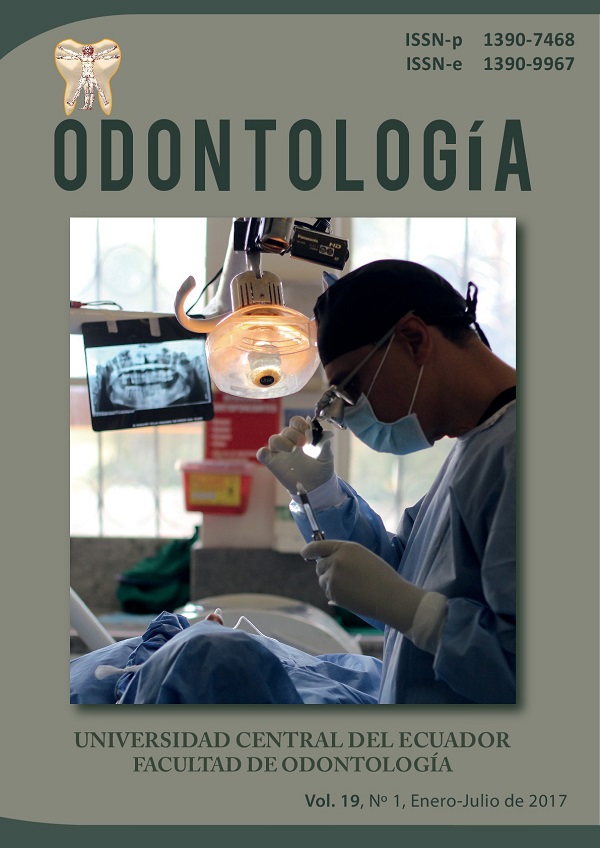Analysis of Bacterial Transmissibility Through the count of CFU Of S. Mutans in Mother-Child
Keywords:
Microbiology, saliva, agar, pediatric dentistryAbstract
Objetive: To identify the mechanisms transmissibility of S. mutans in mother-child binomials, through a count of colonies forming units (CFU). Materials and Methods: we assessed 45 couples mother-child belonging to the Centre of vaccination of The University Hospital of Motupe, which were divided into three groups: G1 (0-6 months); G2 (7-12 months); G3 (13-18 months). Obtained informed consent it was proceeded the collection of data, with the application of a survey to the mothers whose purpose was the assessment of the mechanisms of microbial transmissibility more frequent, following this, the saliva sampling phase was carried out using the swab technique, which were seeded in Salivarius Agar and through a semi quantitative technique, proceeded to evaluate and related the level of S. mutans present in mother and child. The data were analysed statistically with the chi-square test with a significance level of 5%. Results: the bacterium was present in 93% of the children and 100% of the mothers. The highest level of S. mutans was presented in the group of 13 to 18 months with a 33.3%; in the analysis of transmissibility of the mother all presented a high percentage; However, the most frequent polluting habit was “kissing the hands of your child” (93%). The relationship between the level of S. mutans of mother and her child by age group did not show significant differences in any of the age groups (p> 0.05). When analyzing the association between the transmissibility habits of S. mutans in children, it was possible to show that there is an association with kissing in the mouth (p = 0.012). Conclusion: There is an association between the factors of transmissibility and the presence of s. Mutans in children.
Downloads
References
2. Garibay-Rodríguez P. Nivel de Streptococcus del grupo mutans en infantes de 0-24 meses que asistieron a la Unidad del Bebé del Area de de Odontopediatría del IESN en los meses de mayo-junio del 2005. Tesis para optar el Titulo Profesional de Cirujano Dentista. Lima: Universidad Nacional Mayor de San Marcos, Facultad de Odontología; 2005.
3. Mattos-Graner RO, Porter KA, Smith DJ, Hosogi Y, Duncan MJ. Functional Analysis of Glucan Binding Protein B from Streptococcus mutans. Journal of Bacteriology. 2006; 188(11):3813-3825
4. Fraile, M. Microbiología en ciencias de la salud. Madrid: Elsevier; 2003.
5. Cardenas, D. Odontología Pediátrica y del Adolecente. 1ª ed. Colombia: Corporación para Investigaciones Biológicas; 2009.
6. Palomer R L. Caries dental en el niño. Una enfermedad contagiosa. Rev. chil. pediatr. 2006 feb; 77(1): 56-60.
7. Hernández-García T, Damián-Cariño J, Constandse-Cortés D. Determinación del riesgo de caries mediante conteo de UFC de Streptococcus mutans y lactobacilos y capacidad buffer de saliva en un grupo de niños. 7th ed. Ciudad Juárez: Universidad Autónoma de Ciudad Juárez; 2013.
8. Martínez MC, Rodríguez A. Estudio de las cepas de estreptococos del grupo mutans presentes en binomios madre–hijo. Rev Fac Odontol Univ Antioq 2009; 21(2): 177-185.
9. Velásquez O, Elías MCP. Adquisición temprana de Streptococcus mutans y caries dental. Dental Tribune Hispanic & Latin America. Disponible en: http://www.dental-tribune.com/htdocs/uploads/printarchive/editions/c7a2ce4398d077cd-9d8602b121c65984_22-26.pdf.
10. Liebana, J. Microbiología Oral. España: McGraw-Hill - Interamericana; 2002.
11. Negroni. M. Microbiología Estomatológica: fundamentos y guía práctica. 2ª ed. Buenos Aires: Médica Panamericana; 1999.
12. Ojeda, JC, Oviedo, E, Salas, LA. Streptococcus mutans y caries dental. Revista CES Odontología. 2013, 26(1): 44-56.
13. Thorild I, Lindau-Jonson B, Twetman S. Prevalence of salivary Streptococcus mutans in mothers and in their preschool children. International Journal of Paediatric Dentistry. 2002 ene; 12(1): 2-7.
14. Wan, A.K.L., Seow, W.K., Purdie, D.M., Bird, P.S., Walsh, L.J., and Tudehope, D.I. A Longitudinal Study of Streptococcus mutans Colonization in Infants after Tooth Eruption. J Dent Res. 2003; 82(7):504-508.
15. Böneckern M, Rocha R, Rodrigues CRMD. Cariología. En: Guedes-Pinto A, Böneckern M, Rodrigues CRMS. Fundamentos de Odontología Odontopediatría, Ed. Santos, 2009: 133-142.


